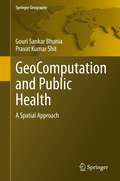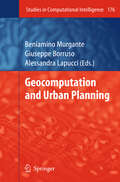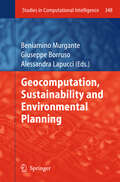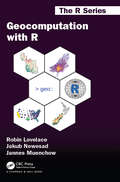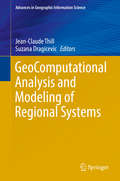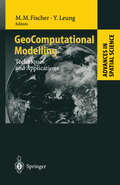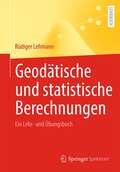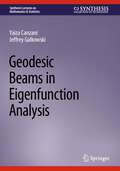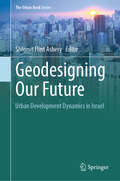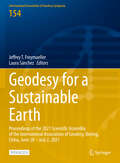- Table View
- List View
GeoComputation and Public Health: A Spatial Approach (Springer Geography)
by Gouri Sankar Bhunia Pravat Kumar ShitGeoComputation and Public Health is fundamentally a multi-disciplinary book, which presents an overview and case studies to exemplify numerous methods and solicitations in addressing vectors borne diseases (e.g, Visceral leishmaniasis, Malaria, Filaria). This book includes a practical coverage of the use of spatial analysis techniques in vector-borne disease using open source software solutions. Environmental factors (relief characters, climatology, ecology, vegetation, water bodies etc.) and socio-economic issues (housing type & pattern, education level, economic status, income level, domestics’ animals, census data, etc) are investigated at micro -level and large scale in addressing the various vector-borne disease. This book will also generate a framework for interdisciplinary discussion, latest innovations, and discoveries on public health. The first section of the book highlights the basic and principal aspects of advanced computational practices. Other sections of the book contain geo-simulation, agent-based modeling, spatio-temporal analysis, geospatial data mining, various geocomputational applications, accuracy and uncertainty of geospatial models, applications in environmental, ecological, and biological modeling and analysis in public health research. This book will be useful to the postgraduate students of geography, remote sensing, ecology, environmental sciences and research scholars, along with health professionals looking to solve grand challenges and management on public health.
Geocomputation and Urban Planning (Studies in Computational Intelligence #176)
by Beniamino Murgante Giuseppe Borruso Alessandra LapucciSixteen years ago, Franklin estimated that about 80% of data contain geo-referenced information. To date, the availability of geographic data and information is growing, together with the capacity of users to operate with IT tools and instruments. Spatial data infrastructures are growing and allow a wide number of users to rely on them. This growth has not been fully coupled to an increase of knowledge to support spatial decisions. Spatial analytical techniques, geographical analysis and modelling methods are therefore required to analyse data and to facilitate the decision process at all levels. Old geographical issues can find an answer thanks to new methods and instruments, while new issues are developing, challenging researchers towards new solutions. This volume aims to contribute to the development of new techniques and methods to improve the process of knowledge acquisition. The Geocomputational expression is related to the development and the application of new theories, methods and tools in order to provide better solutions to complex geographical problems. The geocomputational analysis discussed in this volume, could be classified according to three main domains of applications; the first one related to spatial decision support system and to spatial uncertainty, the second connected to artificial intelligence, the third based on all spatial statistics techniques.
Geocomputation, Sustainability and Environmental Planning (Studies in Computational Intelligence #348)
by Beniamino Murgante Giuseppe Borruso Alessandra LapucciThe experience developed by Ian McHarg represents the first attempt to base environmental planning on more objective methods. In particular, he supposed that the real world can be considered as a layer cake and each layer represents a sectoral analysis. This metaphor represents the fundamental of overlay mapping. At the beginning, these principles have been applied only by hand, just considering the degree of darkness, produced by layer transparency, as a negative impact. In the following years, this craftmade approach, has been adopted for data organization in Geographical Information Systems producing analyses with a high level of quality and rigour. Nowadays, great part of studies in environmental planning field have been developed using GIS. The next step relative to the simple use of geographic information in supporting environmental planning is the adoption of spatial simulation models, which can predict the evolution of phenomena. As the use of spatial information has definitely improved the quality of data sets on which basing decision-making process, the use of Geostatistics, spatial simulation and, more generally, geocomputation methods allows the possibility of basing the decision-making process on predicted future scenarios. It is very strange that a discipline such as planning which programs the territory for the future years in great part of cases is not based on simulation models. Sectoral analyses, often based on surveys, are not enough to highlight dynamics of an area. Better knowing urban and environmental changes occurred in the past, it is possible to provide better simulations to predict possible tendencies.The aim of this book is to provide an overview of the main methods and techniques adopted in the field of environmental geocomputation in order to produce a more sustainable development.
Geocomputation with R (Chapman & Hall/CRC The R Series)
by Robin Lovelace Jakub Nowosad Jannes MuenchowGeocomputation with R is for people who want to analyze, visualize and model geographic data with open source software. It is based on R, a statistical programming language that has powerful data processing, visualization, and geospatial capabilities. The book equips you with the knowledge and skills to tackle a wide range of issues manifested in geographic data, including those with scientific, societal, and environmental implications. This book will interest people from many backgrounds, especially Geographic Information Systems (GIS) users interested in applying their domain-specific knowledge in a powerful open source language for data science, and R users interested in extending their skills to handle spatial data. The book is divided into three parts: (I) Foundations, aimed at getting you up-to-speed with geographic data in R, (II) extensions, which covers advanced techniques, and (III) applications to real-world problems. The chapters cover progressively more advanced topics, with early chapters providing strong foundations on which the later chapters build. Part I describes the nature of spatial datasets in R and methods for manipulating them. It also covers geographic data import/export and transforming coordinate reference systems. Part II represents methods that build on these foundations. It covers advanced map making (including web mapping), "bridges" to GIS, sharing reproducible code, and how to do cross-validation in the presence of spatial autocorrelation. Part III applies the knowledge gained to tackle real-world problems, including representing and modeling transport systems, finding optimal locations for stores or services, and ecological modeling. Exercises at the end of each chapter give you the skills needed to tackle a range of geospatial problems. Solutions for each chapter and supplementary materials providing extended examples are available at https://geocompr.github.io/geocompkg/articles/.
Geocomputation with R (Chapman & Hall/CRC The R Series)
by Robin Lovelace Jakub Nowosad Jannes MuenchowGeocomputation with R is for people who want to analyze, visualize and model geographic data with open source software. It is based on R, a statistical programming language that has powerful data processing, visualization, and geospatial capabilities. The book equips you with the knowledge and skills to tackle a wide range of issues manifested in geographic data, including those with scientific, societal, and environmental implications. This book will interest people from many backgrounds, especially Geographic Information Systems (GIS) users interested in applying their domain-specific knowledge in a powerful open source language for data science, and R users interested in extending their skills to handle spatial data. The book is divided into three parts: (I) Foundations, aimed at getting you up-to-speed with geographic data in R, (II) extensions, which covers advanced techniques, and (III) applications to real-world problems. The chapters cover progressively more advanced topics, with early chapters providing strong foundations on which the later chapters build. Part I describes the nature of spatial datasets in R and methods for manipulating them. It also covers geographic data import/export and transforming coordinate reference systems. Part II represents methods that build on these foundations. It covers advanced map making (including web mapping), "bridges" to GIS, sharing reproducible code, and how to do cross-validation in the presence of spatial autocorrelation. Part III applies the knowledge gained to tackle real-world problems, including representing and modeling transport systems, finding optimal locations for stores or services, and ecological modeling. Exercises at the end of each chapter give you the skills needed to tackle a range of geospatial problems. Solutions for each chapter and supplementary materials providing extended examples are available at https://geocompr.github.io/geocompkg/articles/.
GeoComputational Analysis and Modeling of Regional Systems (Advances in Geographic Information Science)
by Jean-Claude Thill Suzana DragicevicThe contributed volume collects cutting-edge research in GeoComputational Analysis of Regional Systems. The contributions emphasize methodological innovations or substantive breakthroughs on many facets of the socio-economic and environmental reality of regional contexts.
GeoComputational Modelling: Techniques and Applications (Advances in Spatial Science)
by Manfred M. Fischer Yee LeungGeocomputation may be viewed as the application of a computational science paradigm to study a wide range of problems in geographical systems contexts.This volume presents a clear, comprehensive and thoroughly state-of-the-art overview of current research, written by leading figures in the field.It provides important insights into this new and rapidly developing field and attempts to establish the principles, and to develop techniques for solving real world problems in a wide array of application domains with a catalyst to greater understanding of what geocomputation is and what it entails.The broad coverage makes it invaluable reading for resarchers and professionals in geography, environmental and economic sciences as well as for graduate students of spatial science and computer science.
Geocryology: Characteristics and Use of Frozen Ground and Permafrost Landforms
by Stuart A. Harris Anatoli Brouchkov Cheng GuodongThis book provides a general survey of Geocryology, which is the study of frozen ground called permafrost. Frozen ground is the product of cold climates as well as a variety of environmental factors. Its major characteristic is the accumulation of large quantities of ice which may exceed 90% by volume. Soil water changing to ice results in ground heaving, while thawing of this ice produces ground subsidence often accompanied by soil flowage. Permafrost is very susceptible to changes in weather and climate as well as to changes in the microenvironment. Cold weather produces contraction of the ground, resulting in cracking of the soil as well as breakup of concrete, rock, etc. Thus permafrost regions have unique landforms and processes not found in warmer lands. The book is divided into three parts. Part 1 provides an introduction to the characteristics of permafrost. Four chapters deal with its definition and characteristics, the unique processes operating there, the factors affecting it, and its general distribution. Part 2 consists of seven chapters describing the characteristic landforms unique to these areas and the processes involved in their formation. Part 3 discusses the special problems encountered by engineers in construction projects including settlements, roads and railways, the oil and gas industry, mining, and the agricultural and forest industries. The three authors represent three countries and three language groups, and together have over 120 years of experience of working in permafrost areas throughout the world. The book contains over 300 illustrations and photographs, and includes an extensive bibliography in order to introduce the interested reader to the large current literature. Finalist of the 2019 PROSE Awards.
Geocryology: Characteristics and Use of Frozen Ground and Permafrost Landforms
by Stuart A. Harris Anatoli Brouchkov Cheng GuodongThis book provides a general survey of Geocryology, which is the study of frozen ground called permafrost. Frozen ground is the product of cold climates as well as a variety of environmental factors. Its major characteristic is the accumulation of large quantities of ice which may exceed 90% by volume. Soil water changing to ice results in ground heaving, while thawing of this ice produces ground subsidence often accompanied by soil flowage. Permafrost is very susceptible to changes in weather and climate as well as to changes in the microenvironment. Cold weather produces contraction of the ground, resulting in cracking of the soil as well as breakup of concrete, rock, etc. Thus permafrost regions have unique landforms and processes not found in warmer lands. The book is divided into three parts. Part 1 provides an introduction to the characteristics of permafrost. Four chapters deal with its definition and characteristics, the unique processes operating there, the factors affecting it, and its general distribution. Part 2 consists of seven chapters describing the characteristic landforms unique to these areas and the processes involved in their formation. Part 3 discusses the special problems encountered by engineers in construction projects including settlements, roads and railways, the oil and gas industry, mining, and the agricultural and forest industries. The three authors represent three countries and three language groups, and together have over 120 years of experience of working in permafrost areas throughout the world. The book contains over 300 illustrations and photographs, and includes an extensive bibliography in order to introduce the interested reader to the large current literature. Finalist of the 2019 PROSE Awards.
Geocultural Power: China's Quest to Revive the Silk Roads for the Twenty-First Century (Silk Roads)
by Tim WinterLaunched in 2013, China's Belt and Road Initiative is forging connections in infrastructure, trade, energy, finance, tourism, and culture across Eurasia and Africa. This extraordinarily ambitious strategy places China at the center of a geography of overland and maritime connectivity stretching across more than sixty countries and incorporating almost two-thirds of the world’s population. But what does it mean to revive the Silk Roads for the twenty-first century? Geocultural Power explores this question by considering how China is couching its strategy for building trade, foreign relations, and energy and political security in an evocative topography of history. Until now Belt and Road has been discussed as a geopolitical and geoeconomic project. This book introduces geocultural power to the analysis of international affairs. Tim Winter highlights how many countries—including Iran, Sri Lanka, Kenya, Malaysia, Indonesia, Pakistan, and others—are revisiting their histories to find points of diplomatic and cultural connection. Through the revived Silk Roads, China becomes the new author of Eurasian history and the architect of the bridge between East and West. In a diplomatic dance of forgetting, episodes of violence, invasion, and bloodshed are left behind for a language of history and heritage that crosses borders in ways that further the trade ambitions of an increasingly networked China-driven economy.
Geocultural Power: China's Quest to Revive the Silk Roads for the Twenty-First Century (Silk Roads)
by Tim WinterLaunched in 2013, China's Belt and Road Initiative is forging connections in infrastructure, trade, energy, finance, tourism, and culture across Eurasia and Africa. This extraordinarily ambitious strategy places China at the center of a geography of overland and maritime connectivity stretching across more than sixty countries and incorporating almost two-thirds of the world’s population. But what does it mean to revive the Silk Roads for the twenty-first century? Geocultural Power explores this question by considering how China is couching its strategy for building trade, foreign relations, and energy and political security in an evocative topography of history. Until now Belt and Road has been discussed as a geopolitical and geoeconomic project. This book introduces geocultural power to the analysis of international affairs. Tim Winter highlights how many countries—including Iran, Sri Lanka, Kenya, Malaysia, Indonesia, Pakistan, and others—are revisiting their histories to find points of diplomatic and cultural connection. Through the revived Silk Roads, China becomes the new author of Eurasian history and the architect of the bridge between East and West. In a diplomatic dance of forgetting, episodes of violence, invasion, and bloodshed are left behind for a language of history and heritage that crosses borders in ways that further the trade ambitions of an increasingly networked China-driven economy.
Geocultural Power: China's Quest to Revive the Silk Roads for the Twenty-First Century (Silk Roads)
by Tim WinterLaunched in 2013, China's Belt and Road Initiative is forging connections in infrastructure, trade, energy, finance, tourism, and culture across Eurasia and Africa. This extraordinarily ambitious strategy places China at the center of a geography of overland and maritime connectivity stretching across more than sixty countries and incorporating almost two-thirds of the world’s population. But what does it mean to revive the Silk Roads for the twenty-first century? Geocultural Power explores this question by considering how China is couching its strategy for building trade, foreign relations, and energy and political security in an evocative topography of history. Until now Belt and Road has been discussed as a geopolitical and geoeconomic project. This book introduces geocultural power to the analysis of international affairs. Tim Winter highlights how many countries—including Iran, Sri Lanka, Kenya, Malaysia, Indonesia, Pakistan, and others—are revisiting their histories to find points of diplomatic and cultural connection. Through the revived Silk Roads, China becomes the new author of Eurasian history and the architect of the bridge between East and West. In a diplomatic dance of forgetting, episodes of violence, invasion, and bloodshed are left behind for a language of history and heritage that crosses borders in ways that further the trade ambitions of an increasingly networked China-driven economy.
Geocultural Power: China's Quest to Revive the Silk Roads for the Twenty-First Century (Silk Roads)
by Tim WinterLaunched in 2013, China's Belt and Road Initiative is forging connections in infrastructure, trade, energy, finance, tourism, and culture across Eurasia and Africa. This extraordinarily ambitious strategy places China at the center of a geography of overland and maritime connectivity stretching across more than sixty countries and incorporating almost two-thirds of the world’s population. But what does it mean to revive the Silk Roads for the twenty-first century? Geocultural Power explores this question by considering how China is couching its strategy for building trade, foreign relations, and energy and political security in an evocative topography of history. Until now Belt and Road has been discussed as a geopolitical and geoeconomic project. This book introduces geocultural power to the analysis of international affairs. Tim Winter highlights how many countries—including Iran, Sri Lanka, Kenya, Malaysia, Indonesia, Pakistan, and others—are revisiting their histories to find points of diplomatic and cultural connection. Through the revived Silk Roads, China becomes the new author of Eurasian history and the architect of the bridge between East and West. In a diplomatic dance of forgetting, episodes of violence, invasion, and bloodshed are left behind for a language of history and heritage that crosses borders in ways that further the trade ambitions of an increasingly networked China-driven economy.
Geocultural Power: China's Quest to Revive the Silk Roads for the Twenty-First Century (Silk Roads)
by Tim WinterLaunched in 2013, China's Belt and Road Initiative is forging connections in infrastructure, trade, energy, finance, tourism, and culture across Eurasia and Africa. This extraordinarily ambitious strategy places China at the center of a geography of overland and maritime connectivity stretching across more than sixty countries and incorporating almost two-thirds of the world’s population. But what does it mean to revive the Silk Roads for the twenty-first century? Geocultural Power explores this question by considering how China is couching its strategy for building trade, foreign relations, and energy and political security in an evocative topography of history. Until now Belt and Road has been discussed as a geopolitical and geoeconomic project. This book introduces geocultural power to the analysis of international affairs. Tim Winter highlights how many countries—including Iran, Sri Lanka, Kenya, Malaysia, Indonesia, Pakistan, and others—are revisiting their histories to find points of diplomatic and cultural connection. Through the revived Silk Roads, China becomes the new author of Eurasian history and the architect of the bridge between East and West. In a diplomatic dance of forgetting, episodes of violence, invasion, and bloodshed are left behind for a language of history and heritage that crosses borders in ways that further the trade ambitions of an increasingly networked China-driven economy.
Geocultural Power: China's Quest to Revive the Silk Roads for the Twenty-First Century (Silk Roads)
by Tim WinterLaunched in 2013, China's Belt and Road Initiative is forging connections in infrastructure, trade, energy, finance, tourism, and culture across Eurasia and Africa. This extraordinarily ambitious strategy places China at the center of a geography of overland and maritime connectivity stretching across more than sixty countries and incorporating almost two-thirds of the world’s population. But what does it mean to revive the Silk Roads for the twenty-first century? Geocultural Power explores this question by considering how China is couching its strategy for building trade, foreign relations, and energy and political security in an evocative topography of history. Until now Belt and Road has been discussed as a geopolitical and geoeconomic project. This book introduces geocultural power to the analysis of international affairs. Tim Winter highlights how many countries—including Iran, Sri Lanka, Kenya, Malaysia, Indonesia, Pakistan, and others—are revisiting their histories to find points of diplomatic and cultural connection. Through the revived Silk Roads, China becomes the new author of Eurasian history and the architect of the bridge between East and West. In a diplomatic dance of forgetting, episodes of violence, invasion, and bloodshed are left behind for a language of history and heritage that crosses borders in ways that further the trade ambitions of an increasingly networked China-driven economy.
Geodätische und statistische Berechnungen: Ein Lehr- und Übungsbuch
by Rüdiger LehmannDieses Lehr- und Übungsbuch richtet sich an Sie als Studierende und praktisch tätige Fachleute der Geodäsie, der Geomatik, der Vermessung, der Ingenieurmathematik und verwandter Fachrichtungen. Sie erhalten ein theoretisches Grundgerüst, um geodätische und statistische Berechnungen selbst ausführen und fachspezifische Softwareprodukte sachkundig und professionell benutzen zu können.Das Buch enthält 92 teils ganzseitige, farbige Abbildungen und 160 praktische Zahlenbeispiele. Mit deren Hilfe können Sie die vorgestellten Berechnungsverfahren nicht nur theoretisch nachvollziehen, sondern lernen auch deren praktische Anwendung kennen. Weiterhin finden Sie 111 Aufgaben, die Sie selbst lösen und mit den angegebenen Ergebnissen vergleichen können. Die meisten Berechnungen lassen sich auch mit einer kostenlosen Online-Software nachvollziehen, auf die unter den Beispielen und Aufgaben verlinkt wird. Bei der Lektüre kommen Sie ohne besondere mathematische und geodätische Spezialkenntnisse aus. Die praktischen Beispiele und Aufgaben sind sämtlich aus den Bereichen Tachymetrie, Nivellement und den Grundlagen der Satellitennavigation gewählt.
Geodemographics, GIS and Neighbourhood Targeting (Mastering GIS: Technol, Applications & Mgmnt)
by Richard Harris Peter Sleight Richard WebberGeodemographic classification is ‘big business’ in the marketing and service sector industries, and in public policy there has also been a resurgence of interest in neighbourhood initiatives and targeting. As an increasing number of professionals realise the potential of geographic analysis for their business or organisation, there exists a timely gap in the market for a focussed book on geodemographics and GIS. Geodemographics: neighbourhood targeting and GIS provides both an introduction to and overview of the methods, theory and classification techniques that provide the foundation of neighbourhood analysis and commercial geodemographic products. Particular focus is given to the presentation and use of neighbourhood classification in GIS. Authored by leading marketing professionals and a prominent academic, this book presents methods, theory and classification techniques in a reader-friendly manner Supported by private and public sector case studies and vignettes The applied ‘how to’ sections will specifically appeal to the intended audience at work in business and service planning Includes information on the recent UK and US Census products and resulting neighbourhood classifications
Geodesic Beams in Eigenfunction Analysis (Synthesis Lectures on Mathematics & Statistics)
by Yaiza Canzani Jeffrey GalkowskiThis book discusses the modern theory of Laplace eigenfunctions through the lens of a new tool called geodesic beams. The authors provide a brief introduction to the theory of Laplace eigenfunctions followed by an accessible treatment of geodesic beams and their applications to sup norm estimates, L^p estimates, averages, and Weyl laws. Geodesic beams have proven to be a valuable tool in the study of Laplace eigenfunctions, but their treatment is currently spread through a variety of rather technical papers. The authors present a treatment of these tools that is accessible to a wider audience of mathematicians. Readers will gain an introduction to geodesic beams and the modern theory of Laplace eigenfunctions, which will enable them to understand the cutting edge aspects of this theory.
Geodesign by Integrating Design and Geospatial Sciences (GeoJournal Library #111)
by Danbi J. Lee Eduardo Dias Henk J. ScholtenIn Europe, the emerging discipline of geodesign was earmarked by the first Geodesign Summit held in 2013 at the GeoFort, the Netherlands. Here researchers and practitioners from 28 different countries gathered to exchange ideas on how to merge the spatial sciences and design worlds. This book brings together experiences from this international group of spatial planners, architects, landscape designers, archaeologists, and geospatial scientists to explore the notion of ‘Geodesign thinking’, whereby spatial technologies (such as integrated 3D modelling, network analysis, visualization tools, and information dashboards) are used to answer ‘what if’ questions to design alternatives on aspects like urban visibility, flood risks, sustainability, economic development, heritage appreciation and public engagement. The book offers a single source of geodesign theory from a European perspective by first introducing the geodesign framework, then exploring various case studies on solving complex, dynamic, and multi-stakeholder design challenges. This book will appeal to practitioners and researchers alike who are eager to bring design analysis, intelligent planning, and consensus building to a whole new level.
Geodesigning Our Future: Urban Development Dynamics in Israel (The Urban Book Series)
by Shlomit Flint AsheryThis book examines how map-based collaboration software can facilitate negotiations in areas undergoing contentious pressures for significant change. Based on case studies from Israel, it aims to introduce a useful model of planning implementation as an outcome of complex interaction to reduce the gap between planning and urban reality. It puts an analytical realist foundation for a productive discussion of the role of future planning and bares meaningful scientific contributions to the general frame of the negotiating process and implementation, which still needs further research and elaboration.Geodesign, a cutting-edge planning approach that is rooted in the history of planning practice, has become one of the most popular approaches for sustainable planning and design activities after 2000s. Planners tend to think of design at a site scale, but geodesign covers a variety of scales, bridging the gap between the regional and the local contexts.This is important because to be practically effective and politically prudent, "smart growth" plans need to make sense across a spectrum of scales and disciplines. This ranges from design, urban design, community planning, town and city planning, and regional planning, up to planning for mega-regions.
Geodesy: Introduction to Geodetic Datum and Geodetic Systems
by Zhiping Lu Yunying Qu Shubo QiaoGeodetic datum (including coordinate datum, height datum, depth datum, gravimetry datum) and geodetic systems (including geodetic coordinate system, plane coordinate system, height system, gravimetry system) are the common foundations for every aspect of geomatics. This course book focuses on geodetic datum and geodetic systems, and describes the basic theories, techniques, methods of geodesy. The main themes include: the various techniques of geodetic data acquisition, geodetic datum and geodetic control networks, geoid and height systems, reference ellipsoid and geodetic coordinate systems, Gaussian projection and Gaussian plan coordinates and the establishment of geodetic coordinate systems. The framework of this book is based on several decades of lecture noted and the contents are developed systematically for a complete introduction to the geodetic foundations of geomatics.
Geodesy and Physics of the Earth: Geodetic Contributions to Geodynamics (International Association of Geodesy Symposia #112)
by Horst Montag Christoph ReigberGeodesy Beyond 2000: The Challenges of the First Decade, IAG General Assembly Birmingham, July 19–30, 1999 (International Association of Geodesy Symposia #121)
by Klaus-Peter SchwarzIn this volume, the state of the art in geodesy is presented with special emphasis on the challenges of the next decade. It is subdivided into six parts. The first five parts discuss the challenges of providing a stable global reference at the parts per billion level by space methods, the impact of recently approved dedicated satellite missions on the determination of a high resolution global gravity field and its refinements by airborne gravity, advances in geodynamics and their impact on the monitoring of seismic hazards and earthquake prediction, the increasing use of GPS and INS in kinematic mode for mapping the Earth's surface and monitoring the behaviour of large man-made structures, and the related advances in mathematical theory and numerical techniques. The last part is dedicated to the discussion of a new structure for IAG to meet these challenges.
Geodesy for a Sustainable Earth: Proceedings of the 2021 Scientific Assembly of the International Association of Geodesy, Beijing, China, June 28 – July 2, 2021 (International Association of Geodesy Symposia #154)
by Jeffrey T. Freymueller Laura SánchezThis open access volume contains selected papers of the 2021 Scientific Assembly of the International Association of Geodesy – IAG2021. The Assembly was hosted by the Chinese Society for Geodesy, Photogrammetry and Cartography (CSGPC) in Beijing, China from June 28 to July 2, 2021. It was a hybrid conference with in-person and online attendants. In total, the Assembly was attended by 146 in-person participants and 1,123 online participants. The theme of the Assembly was Geodesy for a Sustainable Earth. 613 contributions (255 oral presentations and 358 poster presentations) covered all topics of the broad spectrum considered by the IAG: geodetic reference frames, Earth gravity field modelling, Earth rotation and geodynamics, positioning and applications, the Global Geodetic Observing System (GGOS), geodesy for climate research, marine geodesy, and novel sensors and quantum technology for geodesy. All published papers were peer-reviewed, and we warmly recognize the contributions and support of the Associate Editors and Reviewers.
Geodesy for Planet Earth: Proceedings of the 2009 IAG Symposium, Buenos Aires, Argentina, 31 August 31 - 4 September 2009 (International Association of Geodesy Symposia #136)
by Steve Kenyon, Maria Christina Pacino and Urs MartiThese proceedings include the written version of 130 papers presented at the International Association of Geodesy IAG2009 "Geodesy for Planet Earth" Scientific Assembly. It was held 31 August to 4 September 2009 in Buenos Aires, Argentina. The theme "Geodesy for Planet Earth" was selected to follow the International Year of Planet Earth 2007-2009 goals of utilizing the knowledge of the world’s geoscientists to improve society for current and future generations. The International Year started in January 2007 and ran thru 2009 which coincided with the IAG2009 Scientific Assembly, one of the largest and most significant meetings of the Geodesy community held every 4 years. The IAG2009 Scientific Assembly was organized into eight Sessions. Four of the Sessions of IAG2009 were based on the IAG Structure (i.e. one per Commission) and covered Reference Frames, Gravity Field, Earth Rotation and Geodynamics, and Positioning and Applications. Since IAG2009 was taking place in the great Argentine city of Buenos Aires, a Session was devoted to the Geodesy of Latin America. A Session dedicated to the IAG’s Global Geodetic Observing System (GGOS), the primary observing system focused on the multidisciplinary research being done in Geodesy that contributes to important societal issues such as monitoring global climate change and the environment. A Session on the IAG Services was also part of the Assembly detailing the important role they play in providing geodetic data, products, and analysis to the scientific community. A final Session devoted to the organizations ION, FIG, and ISPRS and their significant work in navigation and earth observation that complements the IAG.
